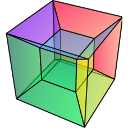Ragged signals#
A ragged array (also called jagged array) is an array created with sequences-of-sequences, where the nested sequences don’t have the same length. For example, a numpy ragged array can be created as follow:
>>> arr = np.array([[1, 2, 3], [1]], dtype=object)
>>> arr
array([list([1, 2, 3]), list([1])], dtype=object)
Note that the array shape is (2, ):
>>> arr.shape
(2,)
Numpy ragged array must have python object type to allow the variable length of
the nested sequences - here [1, 2, 3] and [1]. As explained in
NEP-34,
dtype=object needs to be specified when creating the array to avoid ambiguity
about the shape of the array.
HyperSpy supports the use of ragged array with the following conditions:
The signal must be explicitly defined as being
ragged, either when creating the signal or by changing the ragged attribute of the signalThe signal dimension is the variable length dimension of the array
The
isigsyntax is not supportedSignal with ragged array can’t be transposed
Signal with ragged array can’t be plotted
To create a hyperspy signal of a numpy ragged array:
>>> s = hs.signals.BaseSignal(arr, ragged=True)
>>> s
<BaseSignal, title: , dimensions: (2|ragged)>
>>> s.ragged
True
>>> s.axes_manager
<Axes manager, axes: (2|ragged)>
Name | size | index | offset | scale | units
================ | ====== | ====== | ======= | ======= | ======
<undefined> | 2 | 0 | 0 | 1 | <undefined>
---------------- | ------ | ------ | ------- | ------- | ------
Ragged axis | Variable length
Note
When possible, numpy will cast sequences-of-sequences to “non-ragged” array:
>>> arr = np.array([np.array([1, 2]), np.array([1, 2])], dtype=object)
>>> arr
array([[1, 2],
[1, 2]], dtype=object)
Unlike in the previous example, here the array is not ragged, because the length of the nested sequences are equal (2) and numpy will create an array of shape (2, 2) instead of (2, ) as in the previous example of ragged array
>>> arr.shape
(2, 2)
In addition to the use of the keyword ragged when creating an hyperspy
signal, the ragged attribute can also
be set to specify whether the signal contains a ragged array or not.
In the following example, an hyperspy signal is created without specifying that
the array is ragged. In this case, the signal dimension is 2, which can be
misleading, because each item contains a list of numbers. To provide a unambiguous
representation of the fact that the signal contains a ragged array, the
ragged attribute can be set to True.
By doing so, the signal space will be described as “ragged” and the navigation shape
will become the same as the shape of the ragged array:
>>> arr = np.array([[1, 2, 3], [1]], dtype=object)
>>> s = hs.signals.BaseSignal(arr)
>>> s
<BaseSignal, title: , dimensions: (|2)>
>>> s.ragged = True
>>> s
<BaseSignal, title: , dimensions: (2|ragged)>
